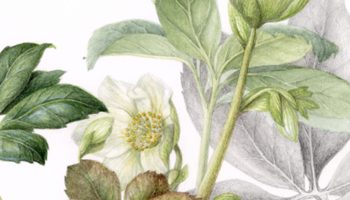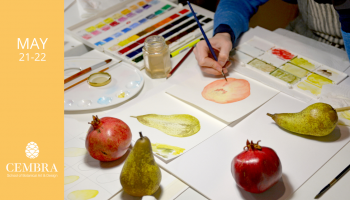5th – 11th July 2024
Painting Wild Flowers in the Historic
Saxon Village of Viscri with
Dr John Akeroyd,
Helen Allen and Irina Neacsu

The village of Viscri, surrounded by glorious and floriferous meadows, will be the setting for this unique course inspired by the paintings in the two volumes that make up the Transylvania Florilegium.

The Transylvania Florilegium was the brainchild of
His Royal Highness the Prince of Wales (now His Majesty, King Charles III)
“When His Royal Highness first visited Transylvania in 1998 he was ‘totally overwhelmed by its unique beauty and its extraordinarily rich heritage’. His Royal Highness saw the importance of this beautiful landscape, rich in meadows, with flora that is extremely rare and vulnerable to changes in farming methods. The Prince suggested it should be recorded in the form of a florilegium. The Transylvania Florilegium would be a means of drawing wider attention to the precious flora. It would not only be a splendid and important publication but also an appeal for the protection of the environment, since the traditionally managed grassland is fundamental to the landscape in a centuries-old managed ecosystem.”
Dr John Akeroyd: The botanist and Transylvania flora specialist will give an insight to the flora and expert advice on botany and related subjects
Helen Allen: Botanical artist and tutor who led the Transylvania project will tell its story of the project through the flora, the eyes of the artists and the paintings
Irina Neacsu: The foremost Romanian botanical artist and tutor living and working in Transylvania
The course will focus on the flowers found in the meadows surrounding Viscri and follow the work of the Transylvania Florilegium artists’ drawings and preparing paintings for the collection.
36 international artists visited two sites, Zalanpatak and Viscri, for two weeks between 2012 and 2016 covering most seasons to produce paintings of meadow flowers for this unique collection.
Although all the artists are experienced painters they worked as teams, supporting and encouraging each other.
Immersion in the landscape and culture of the village plays an important part along with the expert knowledge of botanist John Akeroyd.
Our days are planned in a similar way and a brief description follows:


Friday, July 5th
Afternoon arrival
Arrive in time for drinks and dinner. Post-dinner introduction to the course and working with wild flowers.
Saturday, July 6th
Presentation of Transylvania Florilegium, by Dr. John Akeroyd
Morning session: Visit the Prince’s House to view the Transylvania Florilegium volumes and a presentation by Dr. John Akeroyd and Helen Allen about the project, the various artistic approaches, and the outcome. This might be a good inspiration for chromatics, composition, and model selection in terms of detail and size.
Afternoon session: Sketch in the garden and on the hill just in the back of the garden, where we can indulge ourselves in a wonderful sunset village panorama while getting accustomed to nature, the available plants, and the overall feeling of the place. We will discuss sketching and documenting techniques.
Sunday, July 7th
Choosing the plant specimen
Morning session: Visit the King’s House to view the Transylvania Florilegium volumes and a presentation by Dr. John Akeroyd and Helen Allen about the project, the various artistic approaches, and the outcome. This might be a good inspiration for chromatics, composition, and plant specimen selection in terms of detail and size.
Afternoon session: Sketch in the garden and on the hill just in the back of the garden, where we can indulge ourselves in a wonderful sunset village panorama while getting accustomed to nature, the available plants, and the overall feeling of the place. We will discuss sketching and documenting techniques.
Monday, July 8th – Wednesday, July 10th
Two full days and one-half day of botanical painting
Each day will follow a similar pattern of tutor-guided drawing and painting, discussions, and demonstrations. Instruction will be individual as each participant will follow their own pace. Depending on the weather conditions, we will arrange one afternoon free for optional activities. We recommend exploring the hills on a longer trail by foot or bike (provided at the accommodation for free), visiting the fortified church and the village, as well as just dozing off in the back garden hammock. Those who want can carry on with painting, of course, as the instructors will be on-site for support. At least another walk with Dr. John Akeroyd will be planned.
Thursday, July 11th
Morning session
A show of work; paintings, whether or not completed, and/or sketchbooks – a plenary session to end the course
Departure
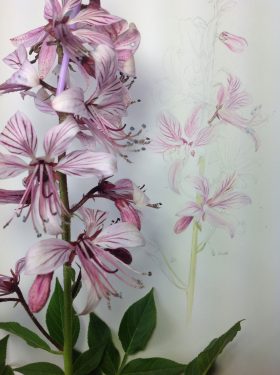
The course will be based at 125 Viscri, a haven of peace, beauty, and tranquility.
The Transylvania Florilegium artists were based here several times during the project and so appreciated the warmth and attention to detail provided by Mihai and Raluca, our hosts.
Rooms are beautifully styled and comfortable with a contemporary but traditional Saxon atmosphere.
Meals are traditional fare sourced locally and from 125’s organic kitchen gardens.
Fees, inclusive of all meals and tuition €1300.00
(For double room; rates vary for single room occupancy)
Wines and additional drinks extra
TRAVEL not included
Detailed itinerary and materials list will be sent when payment has been made
For more information contact:
https://www.viscri125.ro/the-village/
Organizer: Irina Neacsu: www.irinaneacsu.com , irina@irinaneacsu.com
Our hosts, Viscri125: www.viscri125.ro
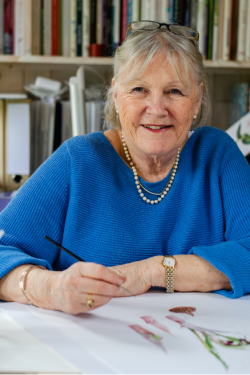 Helen Allen BA,(Hons)PGCert Ed, Dip EGS, FLS
Helen Allen BA,(Hons)PGCert Ed, Dip EGS, FLStrained originally as a textile designer at the University of Leeds and as a teacher at Homerton College, Cambridge, before studying at the English Gardening School in the Chelsea Physic Garden, London. She received the prestigious Diploma in Botanical Illustration and was a course tutor for several years before becoming the Diploma Course Director. In January 2014 she founded a new school, the Chelsea School of Botanical Art at the Chelsea Physic Garden. Helen also paints and teaches at her studio in Ham. Helen has exhibited at galleries including Ebury Galleries, the Garden Museum, the Chelsea Physic Garden and Hortus in London, Ursus Gallery, New York and the Hunt Institute for Botanical Documentation, Pittsburg, USA, the National Botanic Garden for Wales, the Shirley Sherwood Gallery of Botanical Art in the Royal Botanic Gardens, Kew, and Hampton Court Palace. Helen’s work has been selected for inclusion in the Highgrove Florilegium during which she was an active member of the steering group, and the Transylvanian Florilegium, a project she led for five years for HRH The Prince of Wales’s Charitable Foundation and Addison Publications.
 Irina Neacsu
Irina Neacsu Botanical artist, currently a Ph.D. candidate at the Art University in Bucharest and Fulbright Scholar, was trained as an architect, and developed her botanical art from a constant interest in cultural landscapes and intersection points in between culture and nature. Wild flora is her main interest. She has been the recipient of the Oak Spring Garden Foundation botanical art residency grant, the Denver Botanic Garden residency grant, the 2023 ASBA Esther Plotnik Award, and the 2022 RHS Silver Gilt Medal. Her favorite medium is graphite, also combined with watercolor. Her research focuses on Romantic sketches, ecological concerns in 19th-century landscape painting, and, related to Transylvania, the identification of plants in local decorative art patterns.
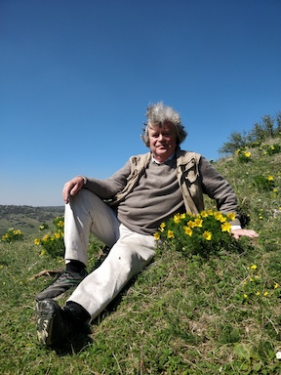 Dr John Akeroyd PhD (Cantab)
Dr John Akeroyd PhD (Cantab)is an English botanist, conservationist, and writer. After studying at the Universities of St Andrews (BSc) and Cambridge (PhD), he carried out post-doctoral research at Trinity College, Dublin, and the University of Reading. Since 1989 he has been a freelance consultant, editor, and writer, including work for the EU Habitats Directive, Bern Convention, and Planta Europa. He was co-founder and editor of Plant Talk, and author of numerous scientific and popular articles. In 2000 he first visited the Saxon Villages region of southern Transylvania and was astonished to find a medieval to 18th-century landscape. Realizing that this is one of the most important cultural and ecological landscapes in Europe, since 2004 he has been working within Fundatia ADEPT, with Romanian, British, and other European colleagues, to promote sustainable development and non-intensive but productive farming and biodiversity conservation. He is the author of scientific papers and popular articles on the region. He researched and wrote the text that accompanies the illustrations of the Transylvania Florilegium.
We know that life can throw many unpredictable aspects our way, and we want to be able to meet you with flexibility. At the same time, we want to protect the good organization of the courses and the lecturers who prepare in time for the meeting with you. That’s why we recommend that you take our cancellation policy into account when you decide to participate in Cembra workshops.
Withdrawal from this course will be different from our normal cancellation policy. The course involves the presence of two lecturers from outside the country, whose transport and accommodation are provided, therefore confirmation of the number of learners is especially important for them.
You will be able to withdraw from this event at least 2 weeks before the scheduled date and we will refund 50% of the course price paid in full upon registration.
Our workshops and courses focus on the study and research of natural subjects through various disciplines, such as botanical art and flower design, landscape design, cyanotype, linocut, ink and textile dye. In forms of short workshops, distance learning, summer schools, art retreats and long term courses, our tutors aim to investigate creative explorations and authentic approaches of urban and wild nature.
